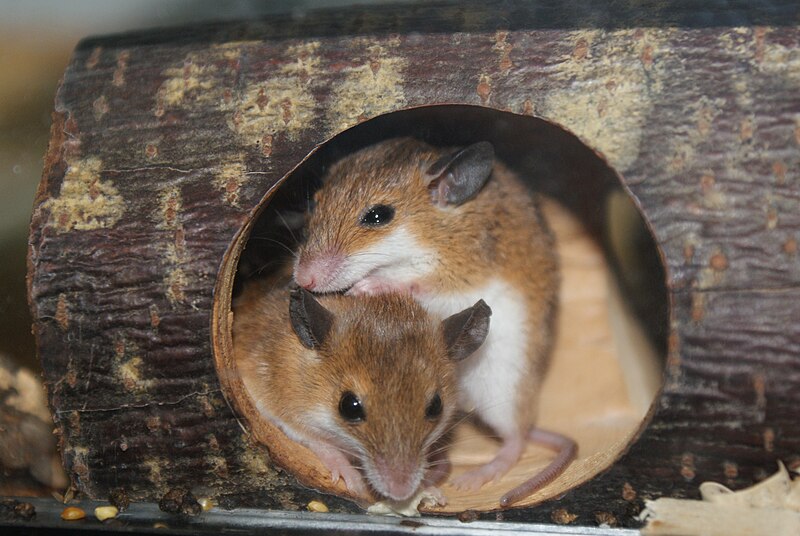 The African Pygmy Mouse (Mus minutoides) is a charming little rodent suitable for those with some mammal-keeping experience…please see Part 1 of this article for more on its care and natural history.
The African Pygmy Mouse (Mus minutoides) is a charming little rodent suitable for those with some mammal-keeping experience…please see Part 1 of this article for more on its care and natural history.
Substrate
Pygmy Mice burrow in the wild – provide yours with 3-4 inches of pine shavings into which they can dig. They will construct enclosed nests, often shared by several individuals, of dry grass or pet nesting material.
Self-constructed burrows are preferable to plastic caves or nest boxes. Pygmy Mice have high metabolisms – condensation from respiration can build up on shelter walls, causing a damp, unhealthy situation (this helps them gather water in the wild – please see Part 1).
Accessories
Fruit tree branches and small logs should be added to provide climbing and gnawing opportunities. If stout beach grass is available, try adding a clump – I’ve had great fun watching Pygmy and Harvest Mice clamber about on the stalks. Small animal toys and chew sticks may also be used.
Temperature
Pygmy Mice withstand quite cold temperatures in some parts of their range, but captives fare best at 70-80 F (temperature tolerance likely varies among different populations). I’ve experienced high losses among chilled African Grass Mice and other rodents that deal with cold weather in the wild – perhaps stress weakens the immune system of captives. In any event, it’s best to play it safe and keep Pygmy Mice warm.
A night-viewing bulb will help you to provide warmth after dark and observe their nocturnal activities.
Diet
House Mice manage to survive on very poor diets (one population in a commercial meat-packing plant eats only beef!) but their tiny African relatives are more delicate. Wild Pygmy Mice consume many insects, and a good supply of protein is important for captives.
A parakeet seed mix and high protein rodent chow can serve as the basis of their diet. Millet sprays hung from the tank’s lid will keep mice and mice-keepers entertained for hours.
Small crickets, waxworms and mealworms should be offered regularly; a mealworm colony will provide grubs, pupae and beetles for the little hunters. If pesticides are not used in the area, try collecting beetles and moths from around outdoor lights – your mice will go wild with excitement!
Other useful protein sources include cage bird egg food and canned insects; some folks favor meat-based tropical fish foods.
Small amounts of fruit, yam, carrot, kale and other greens should be provided 1-2 times weekly.
Pygmy Mice are incessant food hoarders, and cram seeds into check pouches like sawed-off little Chipmunks. They have high metabolisms and should always have food and water (via water bottle) available.
Breeding
An ideal breeding group consists of 1 male and 3 females. Several groups can be housed in larger (30-55 gallon) aquariums, but males may fight if crowded – please see Part 1.
The gestation period is 19-21 days. Litters are small by rodent standards, with an average of 2-4 young (rarely more than 7) being produced. Newborn Pygmy Mice are about the size of pencil erasers and must be seen to be believed! They are weaned at 3-4 weeks of age, and may reach sexual maturity by week 6 (I forestall breeding until they are 3-4 months old). The average captive lifespan is 2-3 years; non-breeders are said to live a bit longer, but I have not confirmed this.
Further Reading
Great video, Pygmy Mouse behavior.
 That Pet Blog That Pet Place Pet Blog
That Pet Blog That Pet Place Pet Blog




I have African pygmy mice in my house. I dont have the heart the kill them so I’ve been catching them humanely and I have a old hamster cage they’ve been staying in. I cant keeping although I want to cause I want to see them live a happy long life but I already have 3, and I’m sure theres more! What do I do some of these little guys are babies and all they know is my house.